高中英语必修四:unit3 Grammar and usage 教案
- 格式:doc
- 大小:126.50 KB
- 文档页数:4
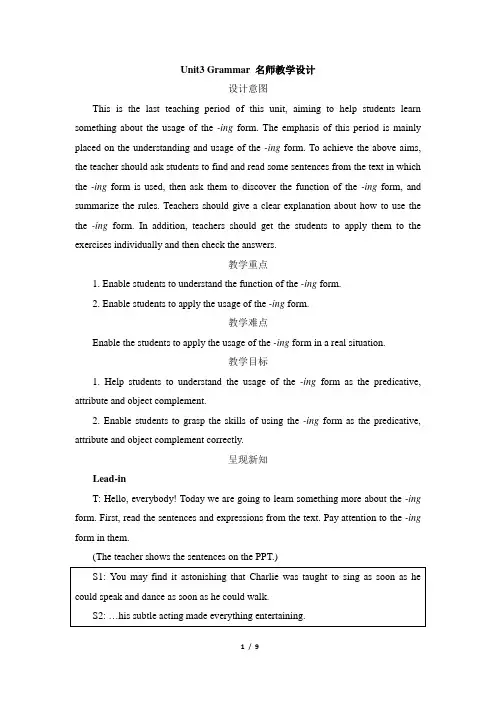
Unit3 Grammar 名师教学设计设计意图This is the last teaching period of this unit, aiming to help students learn something about the usage of the -ing form. The emphasis of this period is mainly placed on the understanding and usage of the -ing form. To achieve the above aims, the teacher should ask students to find and read some sentences from the text in which the -ing form is used, then ask them to discover the function of the -ing form, and summarize the rules. Teachers should give a clear explanation about how to use the the -ing form. In addition, teachers should get the students to apply them to the exercises individually and then check the answers.教学重点1. Enable students to understand the function of the -ing form.2. Enable students to apply the usage of the -ing form.教学难点Enable the students to apply the usage of the -ing form in a real situation.教学目标1. Help students to understand the usage of the -ing form as the predicative, attribute and object complement.2. Enable students to grasp the skills of using the -ing form as the predicative, attribute and object complement correctly.呈现新知Lead-inT: Hello, everybody! Today we are going to learn something more about the -ing form. First, read the sentences and expressions from the text. Pay attention to the -ing form in them.(The teacher shows the sentences on the PPT.)T: From these sentences and expressions, what can you learn about the -ing form?S: In the three expressions, the -ing form is used as the attribute. In the fourth sentence, the -ing form is used as the predicative. Besides, the first three sentences, the -ing form is used as the object complement.(The teacher writes down the function of the -ing form on the blackboard.)感受新知I. Read the sentences in which the -ing form is used as the attribute. Find the differences in the usage of the -ing form.1. The boy standing in the classroom is our monitor.=The boy who is standing in the classroom is our monitor.(动词-ing形式作定语,可表示所修饰的名词的动作或状态,可转化成一个定语从句)2. There is a swimming pool in our school.= There is a pool for swimming in our school.(动词-ing形式作定语,可表示名词的属性、作用或用途,可改为for短语) II. Read the sentences in which the -ing form is used as the predicative. Find the differences in the usage of the -ing form.1. The film we saw last night is quite moving.(-ing形式作表语,可表示主语的某种性质和特征,常看成是形容词)2. His hobby is collecting wine bottles.=Collecting wine bottles is his hobby.(-ing形式作表语,可用来说明主语的内容,表语和主语常可以互换位置) Ⅲ. Read the sentences in which the -ing form is used as the objectcomplement. Summarize the verbs which are followed by the object complement.1. I see a stranger sliding into the manager’s office.2. I heard her singing an English song when I passed by her room yesterday.(表示感觉和心理状态的动词see,hear,feel,watch 等后接宾语补足语,表示动作正在进行)3. We shouldn’t keep our lights burning in the day.(使役动词keep, have, make, get等)IV. Give the students several minutes to read more sentences, and find out the different functions of the -ing form.1. Students are not allowed to speak aloud in the reading room.2. The report is very encouraging.3. Listen! Do you hear someone calling for help?4. The girl swimming in the river is good at dancing.5. Our greatest happiness is serving the people.V. Conclusion.Suggested answers:Ⅵ.Consolidation.用括号内所给动词的适当形式填空1. The villagers saw the fire _____ (burn) brightly in the distance.2. The woman _____ (look) at her map is a relative of my mother.3. Doing nothing is _____ (do) ill.4. His refusal to come to our party was the most _____ (disappoint).5. He gave us an _____ (inspire) speech. We were all _____ (inspire)Suggested answers: 1. burning 2. looking 3. doing 4. disappointing 5. inspiring; inspired归纳拓展I. Read the sentences. Pay attention to the function of the -ing form.(1) He is a promising young man.(2) The woman standing over there is our English teacher.(3) The houses being built are for the teachers.(4) My job is teaching English.(5) They heard him singing in the next room.(6) He was heard singing in the next room.Conclusion:1. Sentences (1) (2) (3)中,动词-ing形式作_____。
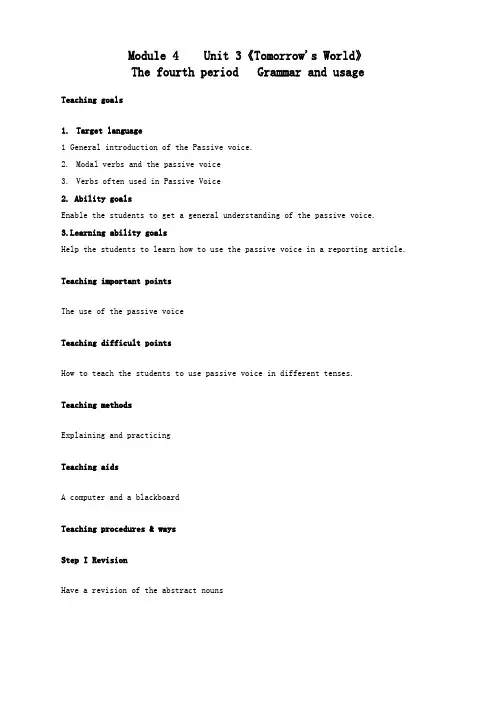
Module 4 Unit 3《Tomorrow's World》The fourth period Grammar and usage Teaching goals1.Target language1General introduction of the Passive voice.2.Modal verbs and the passive voice3.Verbs often used in Passive Voice2. Ability goalsEnable the students to get a general understanding of the passive voice.3.Learning ability goalsHelp the students to learn how to use the passive voice in a reporting article. Teaching important pointsThe use of the passive voiceTeaching difficult pointsHow to teach the students to use passive voice in different tenses.Teaching methodsExplaining and practicingTeaching aidsA computer and a blackboardTeaching procedures & waysStep I RevisionHave a revision of the abstract nounsStep II. GrammarIn this step the students will learn the interchange between the passive voice and the active voice, the basic verb form of the passive voice, and some special passive patterns . Point out the verb, the subject and the object in the following sentences:We keep food in the fridge.The boy broke the glass.We must close the windows and the doorChange these sentences into the passive voice: We keep food in the fridge.The boy broke the glass.You must close the windows and the door.How can we change a sentence into passive voice ?1. Find out the subject of the sentence and use it as the subject of the sentence with the passive voice.2. Decide the tense of the sentence and use the related form of its passive.3. If necessary, use”by” to join the former subject, which should be put in to its object form.When do we use the passive voice ?1. 不知道或没必要指出动作的自行者。
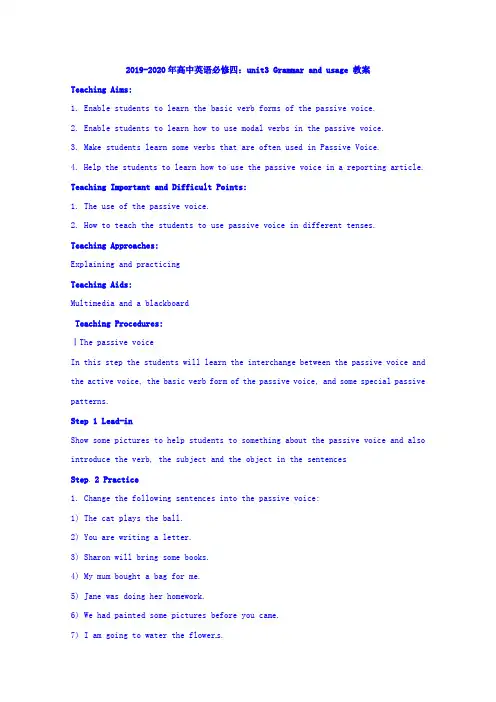
2019-2020年高中英语必修四:unit3 Grammar and usage 教案Teaching Aims:1. Enable students to learn the basic verb forms of the passive voice.2. Enable students to learn how to use modal verbs in the passive voice.3. Make students learn some verbs that are often used in Passive Voice.4. Help the students to learn how to use the passive voice in a reporting article. Teaching Important and Difficult Points:1. The use of the passive voice.2. How to teach the students to use passive voice in different tenses.Teaching Approaches:Explaining and practicingTeaching Aids:Multimedia and a blackboardTeaching Procedures:ⅠThe passive voiceIn this step the students will learn the interchange between the passive voice and the active voice, the basic verb form of the passive voice, and some special passive patterns.Step 1 Lead-inShow some pictures to help students to something about the passive voice and also introduce the verb, the subject and the object in the sentencesStep 2 Practice1. Change the following sentences into the passive voice:1) The cat plays the ball.2) You are writing a letter.3) Sharon will bring some books.4) My mum bought a bag for me.5) Jane was doing her homework.6) We had painted some pictures before you came.7) I am going to water the flower s.8) He told me that they would hold the meeting the next day.2. Make a list of the passive voic e in the different tenses by showing two pictures.3. Fill in the blanks to consolidate wha t they have learnt.1) I ___________ (give) a new book by my father on my birthday. was given2) English ___________ (find) very useful. is found3) The picture ______________ (finish) tomorrow. will be finished4) The bike ______________ (repair) by them now. is being repaired5) The building_________________ (build) this time last year. was being built6) How ______ the flags already _______________(make)? have been made7) The new railway ___________ (build) by the end of last year. had been built8) What_________________ (discuss) now? is being discussed9) Rice ___________ (grow) in the south of the States. is grown10) Jane said her friends_______________ (invite) to her birthday party the next week. would be invitedStep 3 Model verbs and the passive voice1. Introduce the model verbs in the passive voice by showing two sentences. And tell them the structure:modal verb +be done2. Fill in the blanks.1) Some viewers might not _____________ (impress) by the RealCine be impressed2) Special gloves must_________ (wear). be worn3) A real sense of achievement and happiness may________ (feel). be felt3. Do the exercise on Page50.ⅡExercise and summaryIn this period seven points have been showed. Make the summary by doing exercise first. Point 1He often tells us interesting storiesWe are often told interesting stories.Interesting stories are often told to us.When verbs like give, lend, offer, send, tell and show can be followed by two objects,in the passive voice we often use the person as the subject, and sometimes the thing is used .Point2I hear the girl sing English songs.The girl is heard to sing English songs.the active voice → make/see/hear sb. do sth.the passive voice→ sb. be made/seen/heard to do sth.Point3This sweater_______ (wash) well. washesYour article_______ (read) well. readsThe pen________ (write) smoothly. writesThese verbs used in the active voice give a passive meaning.Point4Translate the sentences using get done.1.我的自行车昨晚被偷了。
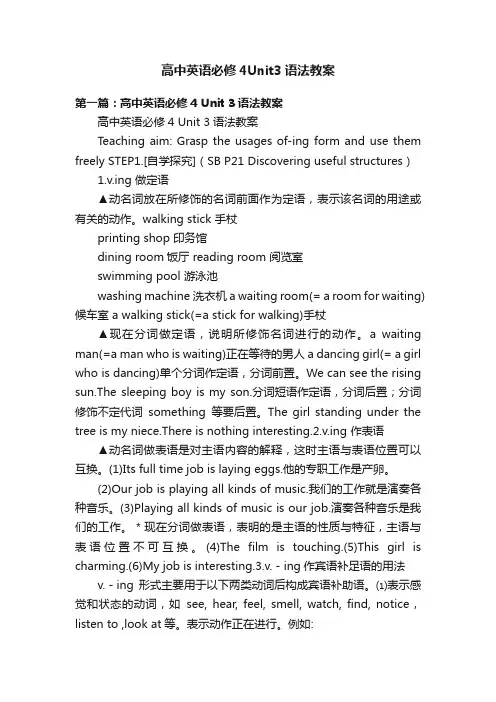
高中英语必修4Unit3语法教案第一篇:高中英语必修4 Unit 3语法教案高中英语必修4 Unit 3语法教案Teaching aim: Grasp the usages of-ing form and use them freely STEP1.[自学探究](SB P21 Discovering useful structures)1.v.ing 做定语▲动名词放在所修饰的名词前面作为定语,表示该名词的用途或有关的动作。
walking stick 手杖printing shop 印务馆dining room饭厅 reading room 阅览室swimming pool 游泳池washing machine洗衣机 a waiting room(= a room for waiting)候车室 a walking stick(=a stick for walking)手杖▲现在分词做定语,说明所修饰名词进行的动作。
a waiting man(=a man who is waiting)正在等待的男人 a dancing girl(= a girl who is dancing)单个分词作定语,分词前置。
We can see the rising sun.The sleeping boy is my son.分词短语作定语,分词后置;分词修饰不定代词something等要后置。
The girl standing under the tree is my niece.There is nothing interesting.2.v.ing 作表语▲动名词做表语是对主语内容的解释,这时主语与表语位置可以互换。
(1)Its full time job is laying eggs.他的专职工作是产卵。
(2)Our job is playing all kinds of music.我们的工作就是演奏各种音乐。
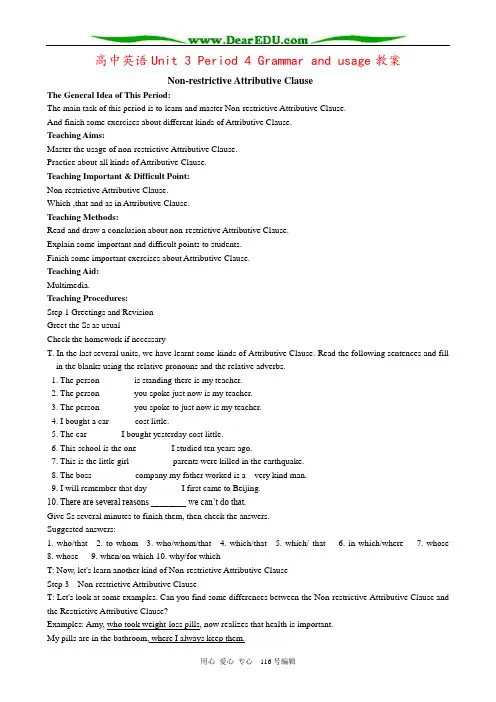
高中英语Unit 3 Period 4 Grammar and usage教案Non-restrictive Attributive ClauseThe General Idea of This Period:The main task of this period is to learn and master Non-restrictive Attributive Clause.And finish some exercises about different kinds of Attributive Clause.Teaching Aims:Master the usage of non-restrictive Attributive Clause.Practice about all kinds of Attributive Clause.Teaching Important & Difficult Point:Non-restrictive Attributive Clause.Which ,that and as in Attributive Clause.Teaching Methods:Read and draw a conclusion about non-restrictive Attributive Clause.Explain some important and difficult points to students.Finish some important exercises about Attributive Clause.Teaching Aid:Multimedia.Teaching Procedures:Step 1 Greetings and RevisionGreet the Ss as usualCheck the homework if necessaryT. In the last several units, we have learnt some kinds of Attributive Clause. Read the following sentences and fill in the blanks using the relative pronouns and the relative adverbs.1. The person _______ is standing there is my teacher.2. The person _______ you spoke just now is my teacher.3. The person _______ you spoke to just now is my teacher.4. I bought a car _____ cost little.5. The car _______ I bought yesterday cost little.6. This school is the one _______ I studied ten years ago.7. This is the little girl _________ parents were killed in the earthquake.8. The boss _________ company my father worked is a very kind man.9. I will remember that day _______ I first came to Beijing.10. There are several reasons ________ we can’t do that.Give Ss several minutes to finish them, then check the answers.Suggested answers:1. who/that2. to whom3. who/whom/that4. which/that5. which/ that6. in which/where7. whose8. whose9. when/on which 10. why/for whichT: Now, let's learn another kind of Non-restrictive Attributive ClauseStep 3 Non-restrictive Attributive ClauseT: Let's look at some examples. Can you find some differences between the Non-restrictive Attributive Clause and the Restrictive Attributive Clause?Examples: Amy, who took weight-loss pills, now realizes that health is important.My pills are in the bathroom, where I always keep them.My cousin, whose body is slim, still wants to lose some weight.We will put off the outing until next month, when Amy feels better.T: Who can answer this question?S1 :There is a comma before the Non-Restrictive Attributive Clause.S2 :The Non-restrictive Attributive Clause can be left outS3 :We can't use "that" in this kind of sentence.T: OK, not bad. And we can't miss the relative words, either.1. He was very rude to the customs officer, which of course made things ever worse.2. The result of the experiment was very good, which we hadn't expected.3. He missed the show, which was a great pity.T: What can you learn from the sentences?Ss: We can use which to refer to the whole main clause.1. Many people, some of whom are not overweight, are going on diets.2. China has hundreds of lands, the largest of which is Taiwan.T: We can find a new kind of Attributive Clause.We can use most/all/some/both/part/of + whom/which to express a complete or partial quantity. Step4 PracticeLet's finish the given exercises on Pages 48-49.(check the answers )Step 5 HomeworkDo some consolidation exercise。
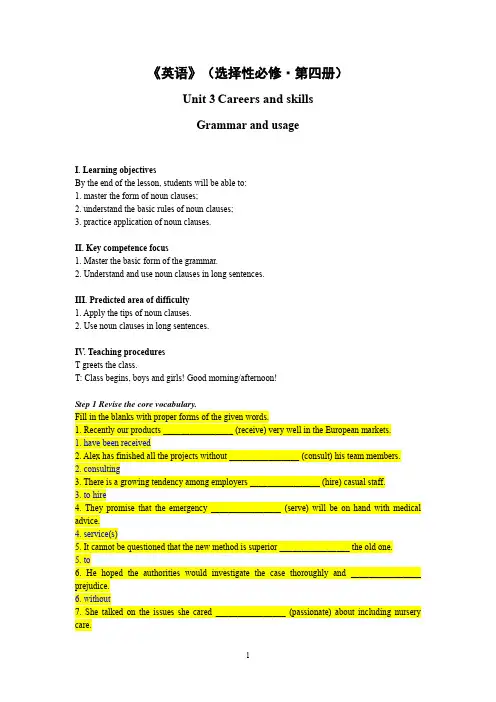
《英语》(选择性必修·第四册)Unit 3Careers and skillsGrammar and usageI. Learning objectivesBy the end of the lesson, students will be able to:1. master the form of noun clauses;2. understand the basic rules of noun clauses;3. practice application of noun clauses.II. Key competence focus1. Master the basic form of the grammar.2. Understand and use noun clauses in long sentences.III. Predicted area of difficulty1. Apply the tips of noun clauses.2. Use noun clauses in long sentences.IV. Teaching proceduresT greets the class.T: Class begins, boys and girls! Good morning/afternoon!Step 1 Revise the core vocabulary.Fill in the blanks with proper forms of the given words.1. Recently our products ________________ (receive) very well in the European markets.1. have been received2. Alex has finished all the projects without ________________ (consult) his team members.2. consulting3. There is a growing tendency among employers ________________ (hire) casual staff.3. to hire4. They promise that the emergency ________________ (serve) will be on hand with medical advice.4. service(s)5. It cannot be questioned that the new method is superior ________________ the old one.5. to6. He hoped the authorities would investigate the case thoroughly and ________________ prejudice.6. without7. She talked on the issues she cared ________________ (passionate) about including nursery care.7. passionately8. The annual interest rates of the two banks are 5.6 percent and 5 percent ________________ (respective).8. respectively9. A tennis player shows good ________________ (anticipate) by moving quickly into position.9. anticipation10. Study shows that Asian-Americans have higher educational ________________ (attain) than any other group.10. attainment【设计意图:上一节课核心词汇较多,有必要复习一下这些内容。
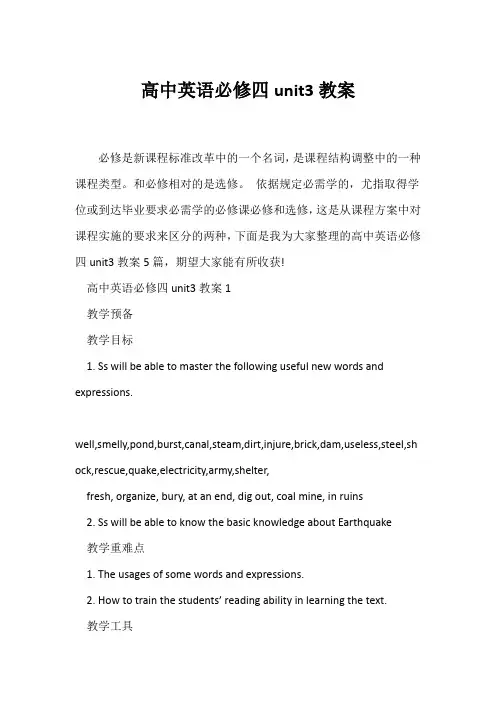
高中英语必修四unit3教案必修是新课程标准改革中的一个名词,是课程结构调整中的一种课程类型。
和必修相对的是选修。
依据规定必需学的,尤指取得学位或到达毕业要求必需学的必修课必修和选修,这是从课程方案中对课程实施的要求来区分的两种,下面是我为大家整理的高中英语必修四unit3教案5篇,期望大家能有所收获!高中英语必修四unit3教案1教学预备教学目标1. Ss will be able to master the following useful new words and expressions.well,smelly,pond,burst,canal,steam,dirt,injure,brick,dam,useless,steel,sh ock,rescue,quake,electricity,army,shelter,fresh, organize, bury, at an end, dig out, coal mine, in ruins2. Ss will be able to know the basic knowledge about Earthquake教学重难点1. The usages of some words and expressions.2. How to train the students’ reading ability in learning the text.教学工具课件教学过程Step I lead-inLet students see a short video and answer the questions1.What happened in the video Earthquakes2.How do you feel seeing the plots(情节) Students’ discussion. Step II Fast reading1. What is the passage mainly about In Tangshan ,earthquakes happened on July 28th 19762. Skim the text and answer the questionsThe type of writing (写作体裁)Narrative writingTopic sentence of Paragraph 1Sentence 1Topic sentence of Paragraph 2Sentence 2Topic sentence of Paragraph 3Sentence 1Topic sentence of Paragraph 4Sentence 1Step III Detailed readingAsk students to read the text carefully and answer the questionsTask1: What were the nature signs of the coming earthquake(选择)Para 11.Water in well( G )2. Well walls(D )3.Chickens pigs(F ) 4 .Mice (A)5.Fish(E )6. Bright lights( B)7. Water pipes(C )A. Ran out of fieldsB. in the skyC. Cracked and burstD. Deep cracksE. Jumped out of pondsF. Too nervous to eatG. Rose and fell, fell and roseTask 2 Fill in the blanksMain IdeaDetailsDamage caused byearthquakePara 2-3At _____ am, the __________ earthquake of the 20th century began . _______ burst from holes in the ground.Hard hills of the rock became rivers of ____.________ covered the ground like red autumn leaves.Two _______ and most of the bridges fell.The railway tracks were now _________pieces of _______.______ now filled the wells instead of water.Water,food,and ______________ were hard to get.The reconstruction(重建) after the earthquakePara 41. The army _____________2. Workers ____________for survivors.3._____________was taken to the city.Details:1. At 3:42 am, the greatest earthquake of the 20th century began.2. Steam burst from holes in the ground.3. Hard hills of the rock became rivers of dirt.4. Bricks covered the ground like red autumn leaves.5. Two dams and most of the bridges fell.6. The railway tracks were now useless pieces of steel.7. Sand now filled the wells instead of water.8. Water, food, and electricity were hard to get.Step IV consolidation (当堂稳固)Let students fill the blanks according to the passageStrange things were happening in the countryside of northeast Hebei. For three days the water in the village wells kept rising and1_________(fall). Farmers noticed that the well walls had deep cracks 2___________ them. A smelly gas came out of the cracks. In3_________farmyards, the chickens and even the pigs were too nervous 4__________(eat). 5_________(mouse) ran out of the fields looking for places 6________(hide). Fish jumped outOf their bowls and ponds. At about 3 am on July 28,1976, some people saw bright lights 7_________ the sky. The sound of planes could 8________(hear) outside the city of Tangshan even 9_________ no planes were in the sky.In the city, the water pipes in some buildings cracked and burst. But the one million people of the city, ________thought little of these events, were asleep as usual that night.1 falling2 in3 the4 to eat5 mice6 to hide 7in 8 be heard 9when 10 who这局部目的是让同学进一步稳固课文的内容。
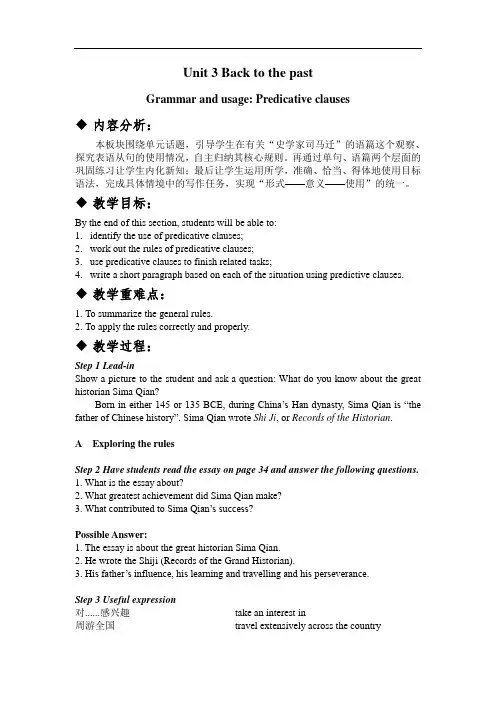
Unit 3 Back to the pastGrammar and usage: Predicative clauses◆内容分析:本板块围绕单元话题,引导学生在有关“史学家司马迁”的语篇这个观察、探究表语从句的使用情况,自主归纳其核心规则。
再通过单句、语篇两个层面的巩固练习让学生内化新知;最后让学生运用所学,准确、恰当、得体地使用目标语法,完成具体情境中的写作任务,实现“形式——意义——使用”的统一。
◆教学目标:By the end of this section, students will be able to:1.identify the use of predicative clauses;2.work out the rules of predicative clauses;e predicative clauses to finish related tasks;4.write a short paragraph based on each of the situation using predictive clauses.◆教学重难点:1.To summarize the general rules.2.To apply the rules correctly and properly.◆教学过程:Step 1 Lead-inShow a picture to the student and ask a question: What do you know about the great historian Sima Qian?Born in either 145 or 135 BCE, during China’s Han dynasty, Sima Qian is “the father of Chinese history”. Sima Qian wrote Shi Ji, or Records of the Historian.A Exploring the rulesStep 2 Have students read the essay on page 34 and answer the following questions.1. What is the essay about?2. What greatest achievement did Sima Qian make?3. What contributed to Sima Qian’s success?Possible Answer:1. The essay is about the great historian Sima Qian.2. He wrote the Shiji (Records of the Grand Historian).3. His father’s influence, his learning and travelling and his perseverance.Step 3 Useful expression对......感兴趣take an interest in周游全国travel extensively across the country获取广泛的信息get a wide range of information继他父亲之后成为太史令succeed his father as Grand Historian方便他接触...... facilitate his access to ...整理可用的资源sort out the available resources需要艰苦的努力require painstaking efforts有效且高效地effectively and efficiently继续某事carry on with sth.被关进监狱be put in prison身体上和精神上physically and mentally无论顺境还是逆境in good times or bad timesStep 4 Have students find the sentences with predicative clauses in the essay and fill in the box of Part A on page 34Learning and travelling were exactly what helped him in his later career as a historian.AnswerHis father’s dream was that one day he could write a great masterpiece recording what had happened in history.His chief concern was whether he could do his job more effectively and efficiently. 【设计意图:通过填空,让学生熟悉文本内容。
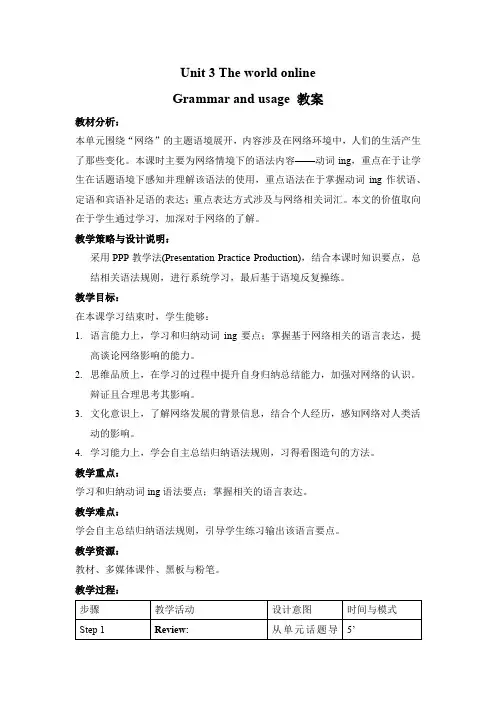
Unit 3 The world onlineGrammar and usage 教案教材分析:本单元围绕“网络”的主题语境展开,内容涉及在网络环境中,人们的生活产生了那些变化。
本课时主要为网络情境下的语法内容——动词ing,重点在于让学生在话题语境下感知并理解该语法的使用,重点语法在于掌握动词ing作状语、定语和宾语补足语的表达;重点表达方式涉及与网络相关词汇。
本文的价值取向在于学生通过学习,加深对于网络的了解。
教学策略与设计说明:采用PPP教学法(Presentation Practice Production),结合本课时知识要点,总结相关语法规则,进行系统学习,最后基于语境反复操练。
教学目标:在本课学习结束时,学生能够:1.语言能力上,学习和归纳动词ing要点;掌握基于网络相关的语言表达,提高谈论网络影响的能力。
2.思维品质上,在学习的过程中提升自身归纳总结能力,加强对网络的认识。
辩证且合理思考其影响。
3.文化意识上,了解网络发展的背景信息,结合个人经历,感知网络对人类活动的影响。
4.学习能力上,学会自主总结归纳语法规则,习得看图造句的方法。
教学重点:学习和归纳动词ing语法要点;掌握相关的语言表达。
教学难点:学会自主总结归纳语法规则,引导学生练习输出该语言要点。
教学资源:教材、多媒体课件、黑板与粉笔。
教学过程:Reading:T asks Ss to read the text, Ss need to answer two questions.plements, also use the sample sentences as examples.Then, T teaches the pattern for main points and guides Ss to think about the differences between them. Next, Ss practice three sentences, and T tells the reason of correct answers.Next, the teacher has students read an article about a website for dance lovers and find the sentences with the verb ing forms. While checking the correct answer, T needs to explain each part of sentences.Finally, T summarises the language rules and highlights the key words.Applying: B1The teacher has students read the four sentences in Part B1 on Page 35 and figure out the functions of the verbing form in the missing parts in each of the four inplete sentences. Students rewrite the four sentences using verbing forms as attributives, adverbials or object plements. While checking the answer, T can also guide Ss to review the function of verbing and why the answer is correct.the topic is. Then plete the conversation with the correct verb ing forms of the verbs. While checking the answer, T can also guide Ss to review the function of verbing and why the answer is correct.Applying: B3T explains the purpose of the task. Then T analyses the first picture (character, items, activities and their mood.) Next, T shows the sentences and matches them with the picture’s contents.Finally, T asks Ss to describe the second picture individually. Alternatively, T could tag the key contents of it.备注:Ss: Students T: TeacherIW: Individual work GW: Group work CW: Class work教学反思1.通过本节内容学习,学生是否掌握动词ing形式,把握材料大意;2.通过本节内容学习,学生能否掌握归纳总结使用该语法方法。
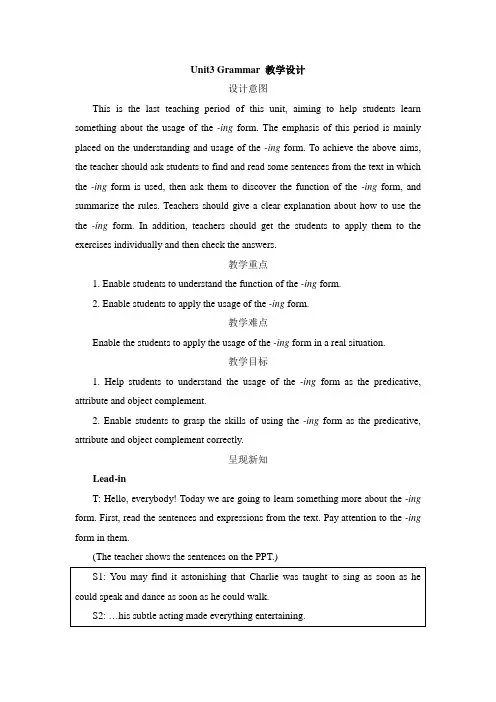
Unit3 Grammar 教学设计设计意图This is the last teaching period of this unit, aiming to help students learn something about the usage of the -ing form. The emphasis of this period is mainly placed on the understanding and usage of the -ing form. To achieve the above aims, the teacher should ask students to find and read some sentences from the text in which the -ing form is used, then ask them to discover the function of the -ing form, and summarize the rules. Teachers should give a clear explanation about how to use the the -ing form. In addition, teachers should get the students to apply them to the exercises individually and then check the answers.教学重点1. Enable students to understand the function of the -ing form.2. Enable students to apply the usage of the -ing form.教学难点Enable the students to apply the usage of the -ing form in a real situation.教学目标1. Help students to understand the usage of the -ing form as the predicative, attribute and object complement.2. Enable students to grasp the skills of using the -ing form as the predicative, attribute and object complement correctly.呈现新知Lead-inT: Hello, everybody! Today we are going to learn something more about the -ing form. First, read the sentences and expressions from the text. Pay attention to the -ing form in them.(The teacher shows the sentences on the PPT.)T: From these sentences and expressions, what can you learn about the -ing form?S: In the three expressions, the -ing form is used as the attribute. In the fourth sentence, the -ing form is used as the predicative. Besides, the first three sentences, the -ing form is used as the object complement.(The teacher writes down the function of the -ing form on the blackboard.)感受新知I. Read the sentences in which the -ing form is used as the attribute. Find the differences in the usage of the -ing form.1. The boy standing in the classroom is our monitor.=The boy who is standing in the classroom is our monitor.(动词-ing形式作定语,可表示所修饰的名词的动作或状态,可转化成一个定语从句)2. There is a swimming pool in our school.= There is a pool for swimming in our school.(动词-ing形式作定语,可表示名词的属性、作用或用途,可改为for短语) II. Read the sentences in which the -ing form is used as the predicative. Find the differences in the usage of the -ing form.1. The film we saw last night is quite moving.(-ing形式作表语,可表示主语的某种性质和特征,常看成是形容词)2. His hobby is collecting wine bottles.=Collecting wine bottles is his hobby.(-ing形式作表语,可用来说明主语的内容,表语和主语常可以互换位置) Ⅲ. Read the sentences in which the -ing form is used as the objectcomplement. Summarize the verbs which are followed by the object complement.1. I see a stranger sliding into the manager’s office.2. I heard her singing an English song when I passed by her room yesterday.(表示感觉和心理状态的动词see,hear,feel,watch 等后接宾语补足语,表示动作正在进行)3. We shouldn’t keep our lights burning in the day.(使役动词keep, have, make, get等)IV. Give the students several minutes to read more sentences, and find out the different functions of the -ing form.1. Students are not allowed to speak aloud in the reading room.2. The report is very encouraging.3. Listen! Do you hear someone calling for help?4. The girl swimming in the river is good at dancing.5. Our greatest happiness is serving the people.V. Conclusion.Suggested answers:Ⅵ.Consolidation.用括号内所给动词的适当形式填空1. The villagers saw the fire _____ (burn) brightly in the distance.2. The woman _____ (look) at her map is a relative of my mother.3. Doing nothing is _____ (do) ill.4. His refusal to come to our party was the most _____ (disappoint).5. He gave us an _____ (inspire) speech. We were all _____ (inspire)Suggested answers: 1. burning 2. looking 3. doing 4. disappointing 5. inspiring; inspired归纳拓展I. Read the sentences. Pay attention to the function of the -ing form.(1) He is a promising young man.(2) The woman standing over there is our English teacher.(3) The houses being built are for the teachers.(4) My job is teaching English.(5) They heard him singing in the next room.(6) He was heard singing in the next room.Conclusion:1. Sentences (1) (2) (3)中,动词-ing形式作_____。
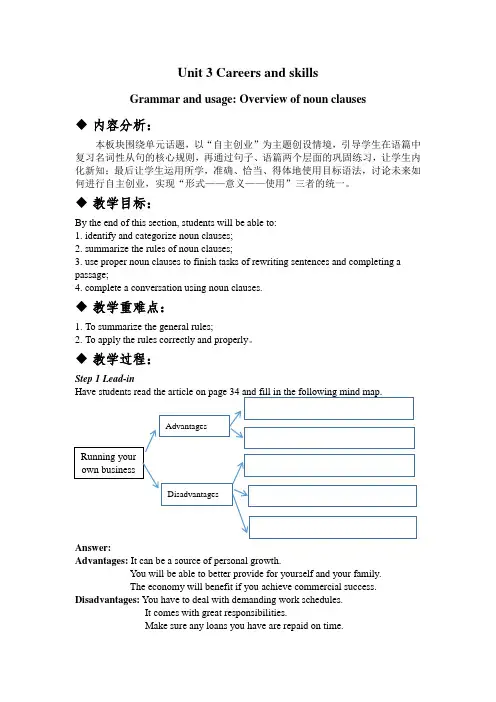
Unit 3 Careers and skillsGrammar and usage: Overview of noun clauses◆内容分析:本板块围绕单元话题,以“自主创业”为主题创设情境,引导学生在语篇中复习名词性从句的核心规则,再通过句子、语篇两个层面的巩固练习,让学生内化新知;最后让学生运用所学,准确、恰当、得体地使用目标语法,讨论未来如何进行自主创业,实现“形式——意义——使用”三者的统一。
◆教学目标:By the end of this section, students will be able to:1. identify and categorize noun clauses;2. summarize the rules of noun clauses;3. use proper noun clauses to finish tasks of rewriting sentences and completing a passage;4. complete a conversation using noun clauses.◆教学重难点:1.To summarize the general rules;2.To apply the rules correctly and properly。
◆教学过程:Step 1 Lead-inAnswer:Advantages: It can be a source of personal growth.You will be able to better provide for yourself and your family.The economy will benefit if you achieve commercial success. Disadvantages: You have to deal with demanding work schedules.It comes with great responsibilities.Make sure any loans you have are repaid on time.Step 2 Exploring the rulesHave students read the article again and fill in the table in part A on page 34.Useful expression孰轻孰重,利弊pros and cons自主创业start your own business将...付诸行动put ... into action权衡优点和缺点weigh up the advantages and disadvantages个人成长的源泉a source of personal growth提高你的领导能力sharpen your leadership skills记录;与...保持联系keep track of取得商业成功achieve commercial success不足为奇的是... It is no surprise that ...首先/一方面...,其次/另一方面... For one thing, ... For another, ...繁重的工作日程demanding work schedules长时间地工作work long hours日以继夜地around the clock制定每周、每月和每年的预算work out weekly, monthly and yearly budgets让公司付出巨大的代价cost the company a great deal危及其他人的工作put other people’s jobs on the line提到...,就...而论when it comes to sth/doing ...三思而后行think twice before you actStep 3 Working out the rulesA noun clause acts like a (1)_____________ and can function as the subject, object, predicative or appositive in the sentence.·We often use linking words like (2)_____________, whether/if or a question word to introduce a noun clause.Answer:(1) noun (2) thatStep 4 Go through the notes on page 100 to 101. Give explanations if necessary.Step 5 Applying the rulesHave students finish B1 on page 35.B1 Rewrite the following sentences using noun clauses according to the requirements in the brackets.1. How do young people decide on a career? I want to know. (object clause)____________________________________________________________________ 2. Does she have enough time to complete so many tasks? This is her doubt. (predicative clause)____________________________________________________________________ 3. The careers adviser suggests that people should think carefully before choosing a job. The suggestion is useful. (appositive clause)____________________________________________________________________ 4. Where will my uncle open his new restaurant? It remains to be seen. (subject clause)_____________________________________________________________________ Answer:1. I want to know how young people decide on a career.2. Her doubt is whether she has enough time to complete so many tasks.3. The careers adviser’s suggestion that people should think carefully before choosing a job is useful.4. It remains to be seen where my uncle will open his new restaurant.Have students finish B2 on page 35 and then answer the following questions.B2 The passage below gives tips on how to start a business. Complete it with proper linking words to form noun clauses.Our first tip for starting a business is to choose a product or service that you find suitable. The fact (1) ________ you have a passion for your idea will make it much easier to motivate yourself. It is also important (2)________ it should fit your skills.A second tip is to analyse your target market carefully to see (3)________ it is worth entering, and if so, how you should run your business. The size of the market and its rate of growth are important factors to consider. (4)________ you can satisfy the needs of potential clients most effectively should be the focus of your business. To achieve that, you need to do some detective work. Do not rely on your subjective judgement. You should also look through the business directory to see who your main competitors will be and find out how their businesses work.Our final tip is (5) ________ you should consider whether you want to make your business a solo one or find one or two partners. Doing it alone can give you greater autonomy. On the other hand, partners can help plug the knowledge or skill gaps.All this groundwork might seem boring when you just cannot wait to get started. However, if you are well prepared, the business you want to open will have a greater chance of success.Answer:(1) that (2) that (3) if/whether (4) How (5) thatHave students finish B3 on page 35.B3 Max is talking to his friend Kate about starting his own business. In pairs, complete the conversation below using noun clauses.Max: I want to start my own business one day.Kate: That’s great! But it’s a lot of hard work. Do you have any ideas (1) __________________________________?Max: Yes! I want to open a fashion design studio-I have some great design ideas. Kate: Make sure you do a lot of research before you start.Max: I definitely will. I want to talk to some people in the fashion industry. I'm interested in (2)________________________________________.Kate: It’s good to talk to experts in the field. (3)_________________________ will definitely help you when you start your business!Answer:(1) what kind of business you want to start(2) how they run their business(3) Whatever you learn from themStep 6 HomeworkFinish Exercise C on P70.教学反思。
《英语》(选修·第一册)Unit 3 On the moveGrammar and usageI. Learning objectivesBy the end of the lesson, students will be able to:1. master the formation of if-clause subjunctive mood;2. understand if-clause subjunctive mood;3. practice application of if-clause subjunctive mood;4. make a conversation about how to improve their hometowns’ traffic using unreal conditionals;5. practise the words: *cater, cater for, hotspot, upgrade*, ferry, *frustration, *install, *emission.II. Key competence focus1. Develop the techniques of the flexible use of language.2. Improve the power of cognition and comprehension.3. Apply learning strategies to practice.III. Predicted area of difficulty1. Applying the tips of if-clause subjunctive mood;2. Using if-clause subjunctive mood.IV. Teaching proceduresT Greet the class.T: Class begins. Good morning/afternoon!Step 1 V ocabulary1. Revise the important words and phrases learnt last period.T: Fill the blanks with the (given) words.1) He walked by my table and ________ (casual) picked up my address book.1) casually2) Once or twice the young lady glanced ________ me over her shoulder.2) at3) He was left with ________ (puzzle) as to the existence or non-existence of God.3) puzzlement4) When the fellows were ________ fault, they came to me and I put them right.4) at5) The past year has seen a ________ (perceive) improvement in working standards.5) perceptible6) If you want to enjoy the service, you must hand in a subscription ahead ________ time.6) of7) The pills can ________ (regulation) your various body functions including your sleeping time.7) regulate8) The place looks much smarter, more in line ________ the image we imagined to project.8) with9) In his latest poems readers ________ (confront) with a series of reflections on death.9) are confronted10) The girls were afraid of snakes and picked their way along with extreme ________ (cautious).10) caution【设计意图:上一节课重要词汇较多,有必要复习一下这些内容。
高中英语必修四unit3教案高中英语必修四 Unit 3 教案教学目标1.通过本单元的学习,学生能够正确理解并运用相关词汇、短语以及语法知识;2.能够熟练运用所学知识,进行听、说、读、写的活动;3.能够培养学生的英语交际能力,提高学生的听力和口语水平。
课时安排本单元共分为5个课时,安排如下: 1. 第一课时:课文阅读与理解(50分钟) 2. 第二课时:语法重点讲解与练习(50分钟) 3. 第三课时:听力训练与口语练习(50分钟) 4. 第四课时:写作技巧培养(50分钟) 5. 第五课时:综合能力测试与复习(50分钟)教学内容与步骤第一课时:课文阅读与理解1.导入(5分钟)–介绍本单元的主题和学习目标;–学生回忆相关的词汇和短语。
–学生自主阅读课文,理解文章大意,并标出生词;–学生分小组讨论课文内容及问题。
3.阅读理解(25分钟)–学生带着问题阅读课文,回答问题并进行讨论;–教师组织小组讨论问题的汇报。
4.总结与拓展(10分钟)–教师对学生的表现进行评价,总结本课时的学习要点;–教师布置相关的课外阅读作业。
第二课时:语法重点讲解与练习1.复习与导入(5分钟)–教师复习上课内容,并引入本课时的语法主题。
2.语法讲解(20分钟)–教师通过PPT讲解本课时的语法知识,包括虚拟语气的用法和结构。
3.练习与巩固(20分钟)–学生进行虚拟语气的练习题,巩固所学知识;–学生分组进行语法对话练习,培养口语能力。
–教师让学生以小组形式编写虚拟语气的对话,并进行表演。
第三课时:听力训练与口语练习1.复习与导入(5分钟)–教师复习上课内容,并引入本课时的听力和口语主题。
2.听力训练(20分钟)–教师播放听力材料,学生进行听力填表练习;–教师带领学生一起检查答案。
3.口语练习(20分钟)–学生分组进行对话练习,练习表达自己的观点和想法;–学生进行角色扮演,模拟实际情境进行口语练习。
4.总结与拓展(5分钟)–教师对学生的表现进行评价,总结本课时的学习要点;–教师布置相关的口语练习作业。
湖南省蓝山二中高一英语必修四《unit3 Grammar and usage》教案牛津版1. Some very interesting technologies are being developed at the moment. (P49) 现在,一些很有趣的技术正在蓬勃发展着。
moment一、moment用作名词,意为“片刻;瞬间”。
如:To everybody's delight, she arrived at the last moment. 使大家感到高兴的是,她在最后一刻赶到了。
二、moment用作名词,意为“重要;重大”。
如:In my opinion, the conversation is of little moment. 依我看,这次会谈不很重要。
三、与moment构成的常用短语。
1. at the moment 意为“此刻”(与现在时连用)或“那时;当时”(与过去时连用)。
如: I'm afraid I'm too busy at the moment to see anyone.很遗憾,我此刻太忙,不能去见任何人。
2. for the moment意为“暂时”。
如:She is out, so you may use her typewriter for the moment.她出去了,你可以暂时使用她的打字机。
3. in a momen t 意为“立刻”。
如:I'll join you in the discussion in a moment.我一会儿和你们一起讨论。
4. for a moment意为“一会儿”。
如:I had to think for a moment before I remembered his name. 我想了一会儿才记起他的名字。
5. at any moment 意为“随时”。
如:He told me I could call him at any moment.他告诉我随时可以给他打电话。
《Grammar and usage》说课稿尊敬的各位评委、老师们:大家好!今天我说课的内容是《Grammar and usage》。
下面我将从教材分析、学情分析、教学目标、教学重难点、教学方法、教学过程以及教学反思这几个方面来展开我的说课。
一、教材分析本节课选自_____教材,这一单元的主题是_____。
语法部分主要涉及了_____的相关内容,这一语法点在英语语言学习中具有重要地位,是构建正确、流畅语句的基础。
教材通过丰富多样的例句和练习,引导学生逐步理解和掌握这一语法规则。
同时,教材中的练习设计具有针对性和层次性,能够满足不同水平学生的需求。
二、学情分析我所教授的学生是_____年级的学生,他们已经具备了一定的英语基础知识和语言运用能力。
但是,对于语法知识的理解和运用还存在一些困难,需要通过系统的学习和练习来提高。
学生在学习过程中可能会出现以下问题:对语法规则的理解不够深入,容易死记硬背;在实际运用中容易犯错,不能灵活运用语法知识;对语法学习缺乏兴趣,认为语法枯燥乏味。
三、教学目标基于对教材和学情的分析,我制定了以下教学目标:1、知识目标学生能够理解和掌握_____这一语法规则,包括其构成、用法和常见的搭配。
2、能力目标学生能够在书面和口头表达中正确运用这一语法规则,提高语言表达的准确性和流畅性。
3、情感目标激发学生学习语法的兴趣,培养学生的合作学习精神和自主学习能力。
四、教学重难点1、教学重点_____这一语法规则的构成和用法,以及在不同语境中的正确运用。
2、教学难点帮助学生区分容易混淆的语法点,引导学生克服在实际运用中出现的错误,培养学生运用语法知识进行创造性表达的能力。
五、教学方法为了实现教学目标,突破教学重难点,我将采用以下教学方法:1、情景教学法通过创设生动的情景,让学生在实际情境中感受和运用语法知识,增强学习的趣味性和实用性。
2、任务驱动法布置具有挑战性的任务,让学生在完成任务的过程中主动探索和运用语法知识,提高学生的语言运用能力。
Unit 3 Tomorrow’ world
Grammar and usage
The passive voice & Modal verbs and the passive voice & Verbs often used in the passive
voice
Teaching Aims:
1. Enable students to learn the basic verb forms of the passive voice.
2. Enable students to learn how to use modal verbs in the passive voice.
3. Make students learn some verbs that are often used in Passive Voice.
4. Help the students to learn how to use the passive voice in a reporting article. Teaching Important and Difficult Points:
1. The use of the passive voice.
2. How to teach the students to use passive voice in different tenses.
Teaching Approaches:
Explaining and practicing
Teaching Aids:
Multimedia and a blackboard
Teaching Procedures:
ⅠThe passive voice
In this step the students will learn the interchange between the passive voice and the active voice, the basic verb form of the passive voice, and some special passive patterns.
Step 1 Lead-in
Show some pictures to help students to something about the passive voice and also introduce the verb, the subject and the object in the sentences
Step 2 Practice
1. Change the following sentences into the passive voice:
1) The cat plays the ball.
2) You are writing a letter.
3) Sharon will bring some books.
4) My mum bought a bag for me.
5) Jane was doing her homework.
6) We had painted some pictures before you came.
7) I am going to water the flower s.
8) He told me that they would hold the meeting the next day.
2. Make a list of the passive voic e in the different tenses by showing two pictures.
3. Fill in the blanks to consolidate wha t they have learnt.
1) I ___________ (give) a new book by my father on my birthday. was given
2) English ___________ (find) very useful. is found
3) The picture ______________ (finish) tomorrow. will be finished
4) The bike ______________ (repair) by them now. is being repaired
5) The building_________________ (build) this time last year. was being built
6) How ______ the flags already _______________(make)? have been made
7) The new railway ___________ (build) by the end of last year. had been built
8) What_________________ (discuss) now? is being discussed
9) Rice ___________ (grow) in the south of the States. is grown
10) Jane said her friends_______________ (invite) to her birthday party the next week. would be invited
Step 3 Model verbs and the passive voice
1. Introduce the model verbs in the passive voice by showing two sentences. And tell them the structure:
modal verb +be done
2. Fill in the blanks.
1) Some viewers might not _____________ (impress) by the RealCine be impressed
2) Special gloves must_________ (wear). be worn
3) A real sense of achievement and happiness may________ (feel). be felt
3. Do the exercise on Page50.
ⅡExercise and summary
In this period seven points have been showed. Make the summary by doing exercise first.
Point 1
He often tells us interesting stories
We are often told interesting stories.
Interesting stories are often told to us.
When verbs like give, lend, offer, send, tell and show can be followed by two objects, in the passive voice we often use the person as the subject, and sometimes the thing is used .
Point2
I hear the girl sing English songs.
The girl is heard to sing English songs.
the active voice → make/see/hear sb. do sth.
the passive voice→ sb. be made/seen/heard to do sth.
Point3
This sweater_______ (wash) well. washes
Your article_______ (read) well. reads
The pen________ (write) smoothly. writes
These verbs used in the active voice give a passive meaning.
Point4
Translate the sentences using get done.
1.我的自行车昨晚被偷了。
My bike got stolen last night.
2.这些蛋已经被打碎了。
The eggs have got broke.
3.工资已经付给了工人们。
The workers have got paid.
Get can also be used in the passive voice instead of be.
Point5
Translate the sentences.
1.据说他很快恢复了。
It is said that he will recover soon.。